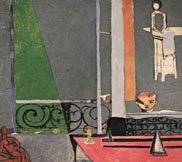2003 Conference on Neuroesthetics
The Neurology of Harmony: Art, Architecture, Music
Paul Klee was right when he said, "Art does not represent the visual world, it makes things visible." We hope that the enormous international enthusiasm that a study of the neural basis of aesthetic experience has generated will prove an effective catalyst in encouraging the neural study of other human activities that may seem remote from the general discipline of neurobiology. It is only by understanding the neural laws that dictate human activity in all spheres - in law, morality, religion and even economics and politics, no less than in art - that we can ever hope to achieve a more proper understanding of the nature of man.
One overall function, common to both artists and scientists makes the function of art an extension of the function of the brain: the acquisition of knowledge, an activity in which the brain is ceaselessly engaged. Such a definition naturally steeps us in a deeply philosophical world, of wanting to learn how we acquire knowledge, what formal contribution the brain makes to it, what limitations it imposes and what neural rules govern the acquisition of all knowledge.
Speakers
Gordon Chung
President, American Institute of Architects
"Harmony and Proportions in Architecture – a Contemporary View"
Nathan Cohen
Artist & Lecturer, Slade School of Fine Art
"Painting between Dimensions – an Equilibrium of Impossibilities"
John Eberhard
Research Planning, American Institute of Architects
"Harmony and Proportions in Architecture – a Historical View"
Patrick Hughes
Artist, London
How Opposing Forces Agree – Look at the Bow and the Lyre (Heraclitus)
Lawrence M. Parsons
Director, Cognitive Neuroscience Program, National Science Foundation
"Brain Systems for the Understanding and Invention of Musical Harmony"
Mark Tramo
Director, Institute for Music & Brain Science, Harvard Medical School
Semir Zeki
Professor, Neurobiology, University College, London

